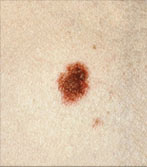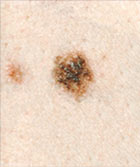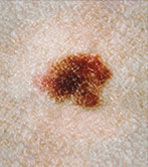
center that doctors may call a “fried egg” appearance.
A dysplastic nevus is a type of mole that looks different from a common mole. (Some doctors use the term "atypical mole" to refer to a dysplastic nevus.)
A dysplastic nevus may be bigger than a common mole, and its color, surface, and border may be different. It is usually more than 5 millimeters wide. A dysplastic nevus can have a mixture of several colors, from pink to dark brown. Usually, it is flat with a smooth, slightly scaly, or pebbly surface, and it has an irregular edge that may fade into the surrounding skin.
A dysplastic nevus may occur anywhere on the body, but it is usually seen in areas exposed to the sun, such as on the back. A dysplastic nevus may also appear in areas not exposed to the sun, such as the scalp, breasts, and areas below the waist.
Some people have only a couple of dysplastic nevi, but other people have more than 10. People who have dysplastic nevi usually also have an increased number of common moles.
Can a dysplastic nevus turn into melanoma?

millimeters in diameter.
Yes, but most dysplastic nevi do not turn into melanoma.
Most remain stable over time. Researchers estimate that the chance of melanoma is about ten times greater for someone with more than five dysplastic nevi than for someone who has none, and the more dysplastic nevi a person has, the greater the chance of developing melanoma.
What should people do if they have a dysplastic nevus?
Everyone should protect their skin from the sun and stay away from sunlamps and tanning booths, but for people who have dysplastic nevi, it is even more important to protect the skin and avoid getting a suntan or sunburn.
In addition, many doctors recommend that people with dysplastic nevi check their skin once a month. People should tell their doctor if they see any of the following changes in a dysplastic nevus:
- The color changes
- It gets smaller or bigger
- It changes in shape, texture, or height
- The skin on the surface becomes dry or scaly
- It becomes hard or feels lumpy
- It starts to itch
- It bleeds or oozes

wide (a little less than 1/2 inch).
Another thing that people with dysplastic nevi should do is get their skin examined by a doctor. Sometimes people or their doctors take photographs of dysplastic nevi so changes over time are easier to see.
For people with many (more than five) dysplastic nevi, doctors may conduct a skin exam once or twice a year because of the moderately increased chance of melanoma. For people who also have a family history of melanoma, doctors may suggest a more frequent skin exam, such as every 3 to 6 months.
Should people have a doctor remove a dysplastic nevus or a common mole to prevent it from changing into melanoma?
No. Normally, people do not need to have a dysplastic nevus or common mole removed. One reason is that very few dysplastic nevi or common moles turn into melanoma.
Another reason is that even removing all of the moles on the skin would not prevent the development of melanoma because melanoma can develop as a new colored area on the skin. That is why doctors usually remove only a mole that changes or a new colored area on the skin.
Source: Vivacare
Last updated : 1/8/2019